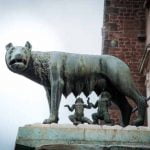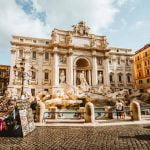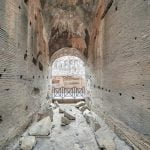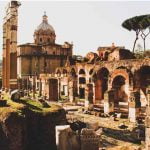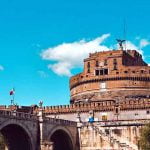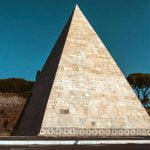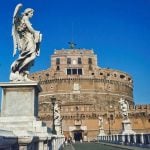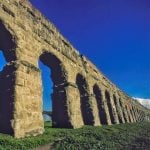Rome is a city of legends, glory, and fame. According to legend, Rome was founded by Romulus and Remus, the sons of Rhea Silvia and god Mars, who were abandoned and nursed by a she-wolf at the foot of the Palatine hill.
According to recent studies and research, Rome, whose name derives from “rumon,” an archaic word meaning river and referring undoubtedly to the Tiber, was probably formed by a gradual fusion of several pastoral and peasant communities whose existence had been established on the hills surrounding the city between the tenth and ninth centuries BC.
The emersion of human settlements in the area was most likely encouraged by the proximity of the sea and the presence of the river, which favored commercial exchanges with the territories located to the north of the Tiber, where the Etruscan civilization was blooming.
Thanks to the strategic position, by the eighth century BC the territory of Rome became a proto-urban center, extending over 100 hectares of land and ruled by the Palatine’s political authority. Subsequently, the town, including Quirinale hill, assumed more structured features until the sixth century BC.
Growing under the rule of three different Etruscan kings, Rome assumed the physiognomy of a true city, with a sacred center on the Capitol, where the first temples were built in honor of the three great gods, Juno, Jupiter, and Minerva, and with a political center at the foot of the Palatine hill.
Since then, the city has known constant development and an evolution that transformed Rome into one of the greatest cities in the world. Today, Rome impresses with countless archaeological monuments, thousands of years of history, and sites that can amaze even the most demanding visitors.
The History Of Ancient Rome
Rome, already settled by the Etruscan kings and other populations, became a defended military camp organized according to the Greek military techniques in the sixth century BC. According to these rules, the city was characterized by a distribution of the citizens in censorship classes, while solid urban walls were protecting the city from intruders.
Organized as a solid military base, the city adopted an expansion policy in the fifth century BC. The Lazio region was the first objective and the situation evolved in favor of Rome who extended its control on the surrounding territories.
The military cooperation between Rome and the Latin League was no longer indispensable for the city, and the Romans, led by Furio Camillo, engaged in the conquering of the rich Etruscan city of Veio, the only city that was threatening Rome’s expansion ambitions. After a siege of ten years, Rome forced Veio ceased to resist and Rome accentuated its hegemony in Lazio.
A few years later, Rome reorganized the Latin League to fight against the Celts who were ruling over the Po Valley and threatening to occupy the whole territory of the city. Counting on the collaboration of the Latin, Rome restored its supremacy in the region.
From this moment on, Rome adopted an aggressive expansion policy and started conquering the territories toward the south of the peninsula. At the time, the city was under an alliance agreement with the Sannites, another Italic population in expansion. Despite the agreement, Rome engaged in a war for the supremacy on Campania and, thanks to some favorable events, it succeeded to ensure its first entrance in the region.
Concerned by the new affirmation of Rome, the Latin League together with other populations of Lazio and Campania, rose against the capital but were defeated between 340 and 338 BC.
As a result, the Latin League was dissolved, the peace treaty Foedus Cassianum was abolished, the whole Latin territory was embedded in the Roman state, and the cities of Campania entered under the Roman supremacy.
However, Rome treated the defeated generously, with the purpose of achieving their cooperation in future battles. The strategy was successful and consequently Rome engaged in more wars, conquering all the territories up to the Adriatic shores and becoming a real threat for the Greek and Etruscan civilizations.
The conquering of the new lands and the expansion of the territory also meant forming a state comprised of a mosaic of peoples and civilizations. To give all those people a feeling of belonging, the political system created by Rome introduced a concept of unified “Italy,” a word originally meaning “land of Itali” an ancient tribe of Calabria whose name was gradually expanded by the Greek to southern Italy and then to the whole peninsula.
This concept helped the various populations overcome the advent of the Roman hegemony and the relations between the cities intensified. The population grew everywhere and trade expanded, favored by the construction of new infrastructures linking the various parts of Italy.
Thanks to the advent of the economy and the prosperity of the Roman state, numerous public buildings and other edifices, such as temples, spas, and aqueducts emerged, not only in Rome but in many other cities as well. This architectural and civil work represented the formation of new professions besides agriculture and farming, which were still fundamental for the economy.
In the meantime, the Roman state continued expanding its territories to the south, reaching Carthage, an active trading city located at the center of the Mediterranean routes between the east and the west.
The two states have been allied for centuries, so Carthage didn’t feel threatened by Rome. However, for Rome, the alliance was no longer sufficient to maintain peace, causing the outbreak of the Punic War. During the war, the strong fleets and trained military of Rome managed to overcome the opponent. Carthage was defeated in the battle of Egadi in 241 BC and Sicily became a Roman province. The Roman state annexed Sardinia and Corsica subsequently.
In the centuries to come, Rome did nothing else but continue its expansion beyond the borders of the peninsula. With time, the Roman state implemented its hegemony further and evolved into a true Empire. By tradition, Roman emperors were all called Augustus, while their successors were Caesars.
One of the greatest emperors of Rome was Diocletian, who ruled the Empire between 284 and 305 AD. Initially a general of modest origins, Diocletian implemented a series of reforms which strengthened his authority and reorganized the state’s administrative, financial, and judicial systems.
In fact, in the century before Diocletian, Rome had witnessed numerous internal struggles and usurpations that had disturbed the life of the Empire. As a result, the new political system implemented by the new emperor involved a so-called tetrarchy.
Diocletian named a second Augustus and shared the political power between the east and west of the empire. Not only that, but each Augustus had to name a Caesar as a direct successor. This transformed succession to the throneinto an automatic act free of controversy.
The two Augustus and Caesars shared government tasks and two capitals were nominated to control the extended territories and boundaries of the empire.
Despite the great system, the tetrarchy didn’t last long and Diocletian abdicated in 305. Following the throne was Constantine, who ruled the empire between 306 and 337. Under his rule, Christianity was implemented throughout the Roman territory, becoming one of the greatest religions in history. By the end of the fourth century, in fact, Christianity became the official religion of the Roman Empire and pagan worship was banned.
The last great figure of Roman emperor was Theodosius, who ruled the Empire between 379 and 395. Theodosius implemented a policy of compromise, allowing many barbarian communities to settle within the confines of the Empire. This permissive policy, together with the division of the Empire in two parts, led to the weakening of the hegemony. Soon after the death of Theodosius, the central power weakened even more due to the inefficiency of the successors. As a result, the barbarian invasions didn’t find any more obstacles and the fate of the Empire began a descending path.
History of Rome
With the fall of the Roman Empire of the West, Rome lost its role as a capital and became a politically degraded city, especially when compared to Constantinople, now called the “New Rome.” Nevertheless, Rome meant much more than current policy. Its prestige derived from the glorious imperial past and the implementation of Christianity, a religion that was still intact in the territory.
As a result, the administration and the reverence of the civil and barbaric world converged upon it. During the Ostrogoth domination in Italy, Rome was honored and evolved, shaping a unique culture.
The Longobard invasion in 568 progressively eroded the Byzantine power, although it didn’t bring major benefits to Rome. Numerous populations were interested in conquering the territory; fortunately for Rome, the territory was of interest for the clergy too, and the city was chosen as a seat for bishops and the Pope.
Rome, therefore, became from a mighty Empire a regional state and a center of Christianity. The early days of the new state were not exactly serene. The patronage imposed on Rome by the French kings and the pope struck susceptibility, while political and administrative interests became disputed between clergy and nobility.
The centuries to come were characterized by political and religious anarchy that concluded, in 1143, with the rise for the first time of a new political will of the middle-class people, comprised of merchants, craftsmen, and smallholders.
These people occupied the Capitol and set up a collegial government named the Sacred Senate. This new Senate was led by a patrician, and municipal institutions contested by the Pope and local bishops spread all over Rome.
The fight for political power between the clergy and the people culminated with the war between Frederick II and the papacy. Frederick II initially honored the papacy, although Pope Gregory IX showed a hostile attitude. Nevertheless, in the last phase of the war the commune became a fearsome power, and fearing that people could have decided the outcome between the papacy and Swabians, the clergy allied with Charles of Anjou.
Thanks to the great power acquired by Charles with the conquest of the Kingdom of Sicily, his rule loomed over Rome. The end of the eleventh century saw Rome struggling with clashes between papacy and nobility until the relentless personality of Pope Boniface VIII was imposed.
The Pope linked his name to the first jubilee, an event that exalted the prestige, multiplied the richness of the city, and instituted the university in 1300. Nevertheless, the name of the Pope was also tied to numerous less fortunate events that led to a dramatic collapse of Boniface VIII, and the movement of the papal residence from Rome to Avignon.
Destroyed by the euphoria and the illusion aroused by the Jubilee, Rome woke up in a society in which ruthless aristocracy, a trivial clergy and a robust middle class without ambitions were failing in organizing a real civility. Under these socially abnormal conditions, Rome achieved a disturbing urban face characterized by fierce contrasts between the remains of the ancient magnificence and the misery of the new plebeian districts.
The century to come witnessed the frequent conflicts between clergy and laity, and the Middle Ages ended with a sort of sumptuous tragedy in which a papacy, majorly political and social rather than religious, covered the deep misery and immorality of the noblest families. The people of Rome were still maintaining their proud dignity, but even the last traces of the city’s grandeur disappeared.
New voices invoking regeneration started to arise, but Rome was not yet prepared to listen to them. The beginning of the fifteenth century found Rome in a true political crisis. The city, from a political point of view, lost its autonomy. Nevertheless, thanks to the innumerable treasures emanating from the patronage of the popes, Rome met an unparalleled primacy in the cultural field and became the true artistic capital of Italy, as well as one of the most beautiful cities in the world.
In fact, the grandeur of the public life, fueled by the wealth of the noble families, was illuminated by the presence of painters, sculptors, and architects who renewed the classical glory of the capital. This represented a new era for the economic and artistic regeneration of the city, and by the end of the sixteenth century the population increased, the tax burden dropped, and the public administration became more careful and responsible.
From there, Rome began ascending again, even if for the centuries to come the city still witnessed battles between clergy and nobility. In 1870 the pope, following the will of the plebiscite, closed himself in the Vatican and a new and tumultuous period opened. The events led to a rapid expansion of the disorder from a political point of view, which broke out in a severe crisis at the end of the nineteenth century.
Meanwhile, the cultural life became more lively and intense, demographic growth became more rapid, and numerous peripheral nuclei which led to an impressive expansion of the territory formed in the city. Nevertheless, the advent of fascism accentuated the phenomenon of poverty by destructing the policy and transforming numerous districts inhabited by craftsmen and low-class people into what some would call ghettos.
During the Second World War, the city suffered serious bombings, and after the proclamation of the armistice between Italy and the Anglo-Americans, the capital was abandoned by the king and the American troops liberated the city from the German occupation.
Archeology of Rome
From all the cities in Italy, and in the world, Rome is one of the richest in archaeological evidence.
Naming all archaeological sites in Rome is impossible. Many of them contain evidence from prehistory and artifacts belonging to the prehistory from the Stone and Bronze Ages, to Etruscans and subsequent populations. The city is also a true open-air museum, boasting countless intact structures and public edifices erected along the centuries.
Since finding archaeology in Rome is so easy, it is probably worth mentioning some of the lesser-known attractions that can offer a unique insight into the various facets of the city. For instance, Underground Rome offers the unique experience of exploring archaeological sites hidden below the surface. Two other archaeological museums worth noting are Ara Pacis
Travel Guides
[wudrelated include="1837"]
Lazio Region of Italy
[wudrelated include="3438"]
Cities of Lazio
[wudrelated include="3752"]

